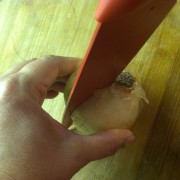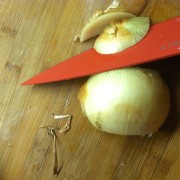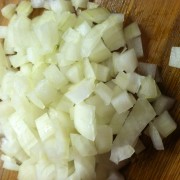But Can You Use A Knife?
Must Have Knife Skills!
That’s what it would say on the top of a want ad I would post for a chef, kitchen assistant, home cook or a husband, for that matter. You may have heard this before…the most important tool for a chef, besides your tongue, is a good knife. If you really want to make some dietary changes and start cooking more at home, or start cooking professionally, you have got to learn how to prepare ingredients quickly and skillfully. The biggest excuse I hear from people who want to start eating healthier and eating more fresh food at home, is that they don’t have time to cook. This is most likely because they are using a lame knife (most likely dull and way too small), and don’t know the proper way to hold it. Cooking the food really doesn’t take much time; most of the work is prepping the ingredients.
The Smaller You Cut It, The Faster It Cooks!
This is basic common sense…a whole potato will take about an 1 1/2 hours to bake. However, if you cut it into 1/2- inch cubes, it will cook in less than half the time. So, for me, this translates to my cutting up some potatoes and other root vegetables, tossing them with salt, onions, garlic and a touch of olive oil, then roasting them in a 425 degree oven for 45 minutes. Now I have already roasted roots available for me to use all week in salads, as a breakfast hash, or even make into a pureed soup; taking just minutes to prepare a healthy meal after a busy work day.
What Brand of Knife Should I Buy?
The brand you buy is really a matter of preference for most folks. There are so many really great knives out there that will range between $80 and $1500 per knife. I love my good old classic Wusthof that I have been using for 20 years. It fits nicely in my huge hand, its has a full tang, high-carbon steel, hand forged and the handle is ergonomically fabulous for the long hours of prep that I put into catering and teaching. I often suggest to people that you go to a kitchen accessories store and try holding each knife to see how it fits in your hand, make note of the knife you like the best; and then go online to see if you can find it at a discount. There are many materials to choose from (stainless steel, high-carbon steel, titanium, ceramic). I prefer high-carbon steel because it lasts, keeps an edge nicely, isn’t too expensive and can take a beating.
What Kind of Knife Should I Use?
Please don’t go out and buy a whole set of knives. You may have already discovered, that you end up using one or two knives from that huge set. The rest sit there in the block taking up space. Most chefs will agree that all you really need to start with is one good chef’s knife, with a blade no shorter than 8 inches. This is the knife we will use for pretty much everything. If you are adding to your tools the next knives that would be helpful would be a serrated slicer and a fileting (or boning) knife. Just make sure you keep your knife sharp by using a steel (no shorter than 12 inches) every single time you use your knife.
Knife Skills 101
I am not going to give you an entire free Knife Skills class right here, because, lets face it, I would rather have you sign up for my next class and learn those skills first hand. However, I do want to help you out a bit, especially with the items that are most difficult to cut.
One of the hardest things for most people, is dicing onions. They fall apart, they are stinky, they make you cry, etc. A few things to remember when attacking the onion: make sure your knife is sharp, so that it slices rather than mashing those stinky juices all over the place. Refrigerate the onion so that the juices won’t defuse into the air as easily. Wipe your knife off with a damp towel in between cuts.
Here are the basic steps to dicing an onion. Just remember that the more cuts and closer they are together, the smaller the pieces will be.
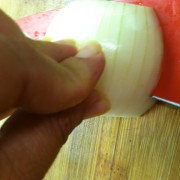
Make sure your cutting board is placed at the edge of the counter. Use your fingers on the top of the onion to put pressure, and make parallel cuts from one cut end toward the other, leaving about 1/4 inch uncut.

Using the tip of the knife, begin cutting (leaving the 1/4 inch uncut), and dragging the knife through. The space between your cuts will determine the size of the dice you end up with.
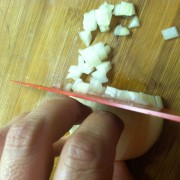
Your hand is in a claw position, with pinky and thumb supporting the food and three guide fingers in front.

